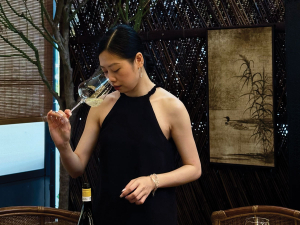"Whereas in China you are converting non-wine drinkers to wine."
She's speaking from a high-speed train in Taiwan, where she and winemaker Matt Thomson have been capitalising on demand for fine wines to accompany fine dining. From there they head to China, where sales are up 340% on 2021, in a market that's now first equal with the United Kingdom for Blank Canvas. "China isn't a quick fix to the surplus we're facing as an industry," Sophie says. "But there is certainly opportunity."
It's a stellar boost off a small base, but this is a market hitting its straps when it comes to New Zealand wine, with exports reaching an all-time high of $51.5 million in March. That's largely thanks to "a direct transition" from red to white varieties in China, "with white wines now dominating sales velocity", says New Zealand Winegrowers China Market Manager Vanessa Wu. "White wine's market penetration has surged from 5% to 20%, with the upward trajectory largely driven by German Riesling and New Zealand's Sauvignon Blanc."
According to official data from China's General Administration of Customs, New Zealand wines achieved parallel growth in both volume and value during 2024. The country's wine imports to China saw a 16.29% year-on-year increase in volume, reaching 3.38 million litres, while import value rose 17.91%. That's against a backdrop of market decline, with imports of French wine dropping 25% in volume from 2022 to 2023, and 17% from 2023 to 2024, with its share of total import volume dipping from 34.1% in 2022 to 28.2% in 2024. According to the latest 2025 data from China's Chamber of Commerce (January-May), New Zealand bottled wine has surged to fifth place in market share (3.07%), overtaking Spain and the US. Vanessa says the figures underscore New Zealand's strengthening position in China's premium white wine segment, "with its signature Sauvignon Blanc continuing to drive market expansion".
The composition of New Zealand's wine exports to China has shifted dramatically as the "white wine revolution" gathers steam, with white wines increasing their share from 67% in 2023 to more than 82% by 2025, "underscoring the category's growing dominance in this strategically important market", Vanessa says. According to IWSR, the global leader in beverage alcohol data and insights, the top selling New Zealand varietal by volume in China in 2024 was Sauvignon Blanc, accounting for 79% of all New Zealand wine sold.
IWSR data shows that Sauvignon Blanc is the second largest overall white wine varietal in China, accounting for 12% of white wine sold by volume in 2024, lagging only behind heavy hitter Chardonnay, which accounted for 44%. Meanwhile, on Alibaba's two major e-commerce platforms, Taobao and Tmall, Sauvignon Blanc was the top selling white wine variety from April 2024 to March 2025, with sales reaching 54 million RMB (NZ$12m), says Vanessa. Riesling and Chardonnay ranked second and third, with sales of 49 RMB and 37m RMB, respectively.
"Things have completely flipped"
Nichole Mao is a partner at China-based company Nimbility, which helps beverage companies build markets and brands throughout Asia. She's had her finger on the pulse of New Zealand wine since 2011, when she started managing the China market for Villa Maria. Since then there have been "huge changes", she says. "From people not knowing where New Zealand is, and not knowing wine can also be white, to now New Zealand Sauvignon Blanc being available across all major retailers from Hema, Sam's Club and others."
She recalls a market visit to the far north in 2012, promoting Villa Maria along with another brand from France. "People weren't paying much attention at all to New Zealand, while they were all focusing on the French brand. Now things have completely flipped."
The import numbers make the white wine trend clear, with Germany and New Zealand growing while all other countries are declining, except for Australia - an outlier due to the lifting of tariffs that effectively locked it out of the market, Nichole says. A key thing to note with the data is that customers are aware that New Zealand white wines need to be drunk fresh, she adds, "so no one would stock up high volume if they cannot sell, meaning no stock piling."
She believes the movement is driven by the "real growth of the China market", with consumers of different age groups and social backgrounds increasingly drinking wine. "This is driven by health concerns, so moving away from Chinese baijiu, in addition to a wine culture that was slowly built in the past years and the growth of Chinese wine offerings."
There’s still a big China market out there for New Zealand companies, considering Zealand’s share in imported wine in China is still very small, Nichole says. “The growth of white wine drinking culture in tier one cities in China will continue to trickle down into lower tier cities.”
Vanessa says the new generation of wine drinkers exhibits distinct preferences – favouring clearly demarcated regional brands, such as Marlborough Sauvignon Blanc, while developing an appreciation for boutique offerings from smaller wineries. “New Zealand’s wine regions, particularly Marlborough and Central Otago, have firmly established their reputation and built formidable category moats in the Chinese market.” Meanwhile, iconic brands like Cloudy Bay and Felton Road “have effectively educated Chinese consumers about New Zealand’s cool-climate wine characteristics through signature varieties such as Sauvignon Blanc and Pinot Noir”, she says. “These premium labels have not only set pricing benchmarks but also created valuable price premiums for the entire New Zealand wine category.”
In recent years, innovative brands such as Oyster Bay have pioneered direct-to-consumer models through e-commerce flagships, with annual sales exceeding 10,000 cases on Tmall, she adds, “demonstrating remarkable channel development leadership in China’s digital wine marketplace”.
 |
|---|
|
Yang Shen
|
Riding the white wine wave
Blank Canvas began exports to China in 2018, working with a “one man band” who had some success but limited reach. In 2021 Sophie and Matt were approached by a larger distributor, based in Hong Kong, and have expanded their footprint ever since. The major shift to white wine preferences has boosted their Sauvignon Blanc and Chardonnay sales, as well as aromatics. They visited for the first time last year and have been “seriously impressed”, while also noting the myriad challenges to navigate along the way, including the need for a different strategy in every province, Sophie says. “It’s so different to any other wine market that we are used to dealing with.”
There’s also good energy around wine education, with the highest level of WSET enrolments in the world. That’s driven by women aged 25 to 45, says Sophie, noting that alcohol consumption has always been male dominated in China. Wine has been “adopted quite strongly by women”, engaging with the educational element, connections, and “sense of gender equality”. Sophie sees that demographic as the “influencers” in the China wine market. “They are the ones who will go on to convert their husbands, and non-wine drinking friends, and we think there’ll be an even more dramatic surge.” She emphasises that as a “slow build”, China is not a solution for the New Zealand wine industry at large. “It will be a long-term strategy to build the market here, as converting non-wine drinkers to drinkers takes time.” All the Asian markets share a common theme in being highly conscious of brand and quality, she adds. “Scores, reputation and authenticity matter hugely.” Exporters also have to be “incredibly careful” with sales channels and strategy. “Online can have immense volume potential but the competitiveness within these businesses mean they will always undercut and very quickly your pricing integrity and brand can be destroyed. You can’t do this if you want to be in on-premise and fine wine retail.”
Pioneering New Zealand wine
The growing foothold of New Zealand wine in China comes as no surprise to Cloudy Bay Estate Director Yang Shen, who hails from Chengdu in the Sichuan province. Cloudy Bay has been in the Asia Pacific market, and particularly more mature markets of Japan and Hong Kong, since the early 2000s. But when Yang took up his role in 2016, Cloudy Bay’s parent company, LVMH, had the Chinese market in view. For the past seven years the company has followed a strategy there, and in neighbouring markets influenced by Chinese culture, including Singapore, Malaysia and Korea.
As the company once opened doors for New Zealand producers in the UK and other now-established markets, it’s again creating categories for New Zealand wine in Asia, with a substantial share of New Zealand wine exports to China, and of the super-premium wine category in Korea, he says. “I think we are still playing the role of Cloudy Bay as pioneer, to put the industry into those countries – as they did 20 years ago, or 40 years ago in some markets.”
Nichole Mao says brands like Cloudy Bay have been very important in “pioneering” New Zealand wine in China. “With language difference, it is very important for Chinese consumers to have a name that they can remember and connect the country with,” similar to the impact of Lafite with France and Penfolds with Australia.
The shift to white wine preferences is also no surprise to Yang, who recognised it simply as a missing category. People have looked at statistics in China and Asia to label them as red wine markets, but all wine categories there are new, he says. “The wine culture is western culture. Regardless of whether it is red or white, the wine culture has been imported… It is a lifestyle thing, not part of tradition, and there’s always opportunity for any imported culture to be accepted.”
The market changes quickly, and operators need to be nimble, with competition from other countries and other alcoholic beverages a constant challenge. “People can choose between sparkling or Champagne, or a glass of Cloudy Bay or a glass of something else,” Yang says. Remaining a market leader requires strategies to open minds. “It’s just about right target, right moment, right opportunities and right occasions.”
 |
|---|
|
Dave Tyney
|
Cultural nuances
Marlborough winemaker David Tyney says China offers a “reliable and rewarding” market for wineries focused on premium, distinctive wines. “The primary consumer segment consists of young professionals eager to explore global wines. Quality and uniqueness are major selling points, and many are willing to pay a premium for products that deliver both.”
But despite the potential for some producers, China’s wine market is complex, shaped by “cultural and demographic nuances”, David says, cautioning that it is unlikely to become a high-volume market for New Zealand wines. “Of the country’s 1.4 billion people, approximately 100 million are regular wine consumers, with imported wine accounting for 10-20% of total consumption,” David says. “While total imports exceed USD$1b, this remains relatively modest in scale.”
David has been exporting Cirro Wines to China since 2012, when he was invited to participate in a winemaking competition in Ningxia. Since then, he has certainly leant into the market, both for winemaking consultancy roles and Cirro sales, with the latter taking the lion’s share of his time these days. He started with a single pallet, half of which was red wine, and in the time since has seen consistent growth of 15-20% per annum in China, and a shift to greater demand for white wines.
New Zealand’s reputation in China extends beyond wine, he says. “Consumers are already familiar with our dairy, tourism and kiwifruit industries, so the idea that New Zealand produces quality wines is well received. The market has matured significantly over the past 13 years, with increasing numbers of wine professionals “and a steady influx of wine enthusiasts and students eager to expand their knowledge”. In more recent years, demand for New Zealand wines has accelerated, “particularly for unique offerings that showcase regional or varietal diversity,” he adds. “There’s a real appetite for discovery and differentiation.”
David spent much of May and June travelling through Asia, including as part of a Mayoral trade delegation to Ningxia – Marlborough’s sister region – and Chengdu during May. The delegation included Marlborough Mayor Nadine Taylor and other council members, as well as Nelson Marlborough Institute of Technology (NMIT) Executive Director Olivia Hall. Several meetings were held with government leaders and universities during the visit and agreements were signed between NMIT and Ningxia University wine school, and the Ningxia Institute of Science and Technology.
David participated in the Wine 2 Asia international tradeshow in Shenzhen, China, and at the NZW China Roadshow in Guangzhou, Shanghai and Qingdao, where there was high interest in all New Zealand wine varieties, he says. “The China market is evolving quickly, and I observed a trend towards single vineyard and alternative varietal wines.”
He also attended a New Zealand tasting event in Seoul, and notes that New Zealand wine is one of the few categories experiencing growth in Korea. New consumers are discovering New Zealand wines for the first time, and there’s solid momentum surrounding the country’s offerings.” Then it was Vinexpo in Singapore, which attracted buyers from China, South Korea, Japan, and ASEAN countries. “NZW facilitated a busy stand with six participating wineries, and most interactions were with serious buyers knowledgeable about wine,” David says.
 |
|---|
|
Nichole Mao
|
Leveraging future opportunity
Vanessa Wu says China’s imported wine market has navigated a decade of fluctuations, with particularly challenging conditions during the 2022-2024 period, “though signs of recovery are now emerging”. Industry analysts anticipate long-term market stabilisation with imported wines demonstrating strong growth potential, she says. “Within this evolving landscape, New Zealand wines have undergone remarkable transformation in China, especially over the past four to five years. The rising popularity of white wines among Chinese consumers, particularly younger demographics, has created significant opportunities for New Zealand producers.”
Ian Ford, a founding partner of Nimbility, imported a Villa Maria wine into China in late 1999 –one of the first New Zealand wines in the market. Since that time New Zealand in general has pursued a quality positioning within the wine sector, largely avoiding “the race to the bottom” on prices, he says. “New Zealand wines by and large missed out on the conspicuous consumption of the early wine boom, the extravagant banquets and gifting that favoured Bordeaux and later Penfolds. But the category is now very well positioned to attract the hearts and minds of new younger wine consumers who are seeking out the wines that they truly love to enjoy.
An FTA Case Study
The China market has always required perseverance and patience, says Charlotte Read, New Zealand Winegrowers General Manager Brand, who lived in China from 2012 to 2017, as an export manager for a New Zealand winery and a food and beverage programme lead for New Zealand Trade and Enterprise. “It’s rewarding to see that has paid off since the Free Trade Agreement was signed in 2008.” China will be a good case study if and when New Zealand achieves an FTA with India, Charlotte says. “Post FTA it takes a lot of time and education and events – it could take a decade or two before you get good traction.”
There’s been a transition to “real demand” for New Zealand wine in China, rather than the “opportunistic sales” of people buying for gifting or banqueting, inspired more by “a pretty box” than knowledge of the wines themselves, she says. New Zealand and Germany represent the most visible green shoots in the market, along with a resurgence from Australia after China ended four years of tariffs that effectively blocked its wine from the market. “But generally, when you hear people talking about wine in China, they are talking about the rise of white wine from New Zealand and Germany.”
In 2013, Charlotte spoke to the New Zealand Herald about huge potential for New Zealand Sauvignon Blanc in the Chinese premier wine market. Twelve years on, the shift to white wine is an exciting development for companies that put in the time and effort. “It’s a true opportunity, but you have to be measured in how you do it. It’s not going to be an overnight success story… You have to build a strong business brick by brick.”















